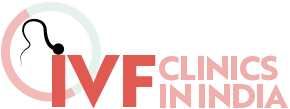In vitro fertilization (IVF) is a complex series of procedures used to help with fertility or prevent genetic problems and assist with the conception of a child.During IVF, mature eggs are collected (retrieved) from ovaries and fertilized by sperm in a lab. Then the fertilized egg (embryo) or eggs (embryos) are transferred to a uterus. One full cycle of IVF takes about three weeks. Sometimes these steps are split into different parts and the process can take longer.
IVF is the most effective form of assisted reproductive technology.
In vitro fertilization (IVF) also called test tube baby is an assisted reproductive technology where in an egg is fused with the sperm outside the body (In Vitro). In this process the women ‘s ovaries are stimulated using daily hormonal injections of highly pure HMG or recombinant FSH starting from Day 2 of the menstrual cycle for 9 to 11 days. When the leading follicle is > 14 mm, a daily dose of GnRh antagonist is additionally given to the patients. When at least 2 follicles are 17 mm , HCG trigger is given and the eggs are retrieved after 35 to 36 hours. If there are too many follicles, then instead of HCG a dose of Gnrh agonist is given to prevent hyper stimulation and not over stimulation of the ovaries. The egg retrieval is done under short General anaesthesia or local anaesthesia, by using a very thin needle. This needle is passed through the vagina under ultrasound guidance. The egg retrieval takes about 10 to 20 minutes & the patients can go home in 4 to 6 hours. Once the eggs are isolated in the lab, the husband is asked to produce sperms by masturbation. The sperms are processed using various techniques such as swim up, density gradient, microfluidics or Magnetic Assisted Cell Sorting MACS. Following the processing of the semen, about 1,00,000 healthy forwardly motile sperms are mixed with the wife’s egg in a petri dish in the embryology lab. The fertilized eggs are called the embryos which are cultured and on day 3( 8 cell cleavage stage embryo ) or day 5 (150 cells blastocyst) is released back into the wife’s womb with the help of a procedure called Embryo Transfer Sometimes on the day of IVF the Husband may fail to produce semen by masturbation , due to psychological pressure . Hence our unit always request the husband to produce one more semen sample, a few days prior to the egg pick up and freeze that semen sample as a back up.
In Intracytoplasmic sperm injection
(ICSI) is a highly specialized ART technique wherein a single sperm is injected directly into the cytoplasm of an egg using a machine called the micropmanipulator . In these all the steps are similar to the steps of IVF , except the step of sperm fertilising the egg . ICSI is very helpful in cases where a couple has had semen in which the sperm count is low or has poor motility or bad morphology .It is also the method of choice for patients with azoospermia wherein sperms are extracted from the testis ,in patients with previous fertilisation failure with IVF , advanced maternal age, etc This technique is also used for frozen eggs or eggs that are matured in Vitro (IVM) or in patients undergoing Preimplantation GeneticTesting . Nowadays, many units are using this technique instead of IVF, even in patients who have totally normal semen parameters (also called non male factor infertility )
